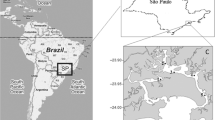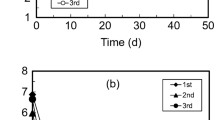Abstract
Purpose
Sulfate-reducing bacteria (SRB) have received particular attention in the bioremediation of sediments contaminated with heavy metals. In this study, indigenous SRB were used to stabilize Cd in sediments spiked with different Cd concentrations (≤ 600 mg kg−1).
Materials and methods
The study investigated the Cd leaching efficiency from sediments after 166 days (d) of biotreatment and assessed the bacterial community and bacteria relationship in sediments during SRB biostabilization.
Results and discussion
The study found that the Cd leaching efficiency of sediments was reduced by 18.1–40.3% (29.4 ± 8.7%) after 166 days of biotreatment. During the biostabilization, the bacterial community in sediments significantly changed, particularly after 61 days of biotreatment. At the family level, the identified dominant bacteria (mean abundance > 3%) included Bacillaceae, norank Nitrospira, Anaerolineaceae, Nitrospinaceae, Streptococcaceae, and Hydrogenophilaceae. The study also speculated the complex relationships between these bacteria. The relative abundance of Desulfobacteraceae and Desulfobulbaceae in sediments was enhanced after biotreatment. Bacillaceae and Streptococcaceae may play a negative role in Cd biostabilization and inhibited SRB biological activity. However, Anaerolineaceae and Hydrogenophilaceae may have commensalism and mutualism relationships, respectively, with typical SRB. The presence of Nitrospinacea and norank Nitrospira may reduce the inhibitive effect of denitrifying bacteria on SRB, thereby exhibiting a positive effect on biologic sulfate reduction and Cd biostabilization.
Conclusions
Indigenous SRB treatment increased Cd stability in sediments and changed bacterial community. During SRB biostabilization, complex relationships between bacteria in sediments were speculated, including competition, syntrophism, and antagonism. These results provide insights for better regulating and controlling SRB biostabilization.


Similar content being viewed by others
References
Agrawal A, Park HS, Nathoo S, Gieg LM, Jack TR, Miner K, Ertmoed R, Benko A, Voordouw G (2012) Toluene depletion in produced oil contributes to souring control in a field subjected to nitrate injection. Environ Sci Technol 46:1285–1292
Akcil A, Erust C, Ozdemiroglu S, Fonti V, Beolchini F (2015) A review of approaches and techniques used in aquatic contaminated sediments: metal removal and stabilization by chemical and biotechnological processes. J Clean Prod 86:24–36
Alasvand ZK, Rai VR (2014) Microorganisms: induction and inhibition of corrosion in metals. Int Biodeterior Biodegrad 87:66–74
Basak P, Majumder NS, Nag S, Bhattacharyya A, Roy D, Chakraborty A, SenGupta S, Roy A, Mukherjee A, Pattanayak R, Ghosh A, Chattopadhyay D, Bhattacharyya M (2015) Spatiotemporal analysis of bacterial diversity in sediments of Sundarbans using parallel 16S rRNA gene tag sequencing. Microb Ecol 69:500–511
Blum JS, Bindi AB, Buzzelli J, Stolz JF, Oremland RS (1998) Bacillus arsenicoselenatis, sp. nov. and Bacillus selenitireducens, sp. nov.: two haloalkaliphiles from Mono Lake, California that respire oxyanions of selenium and arsenic. Arch Microbiol 171:19–30
Burton GA (2010) Metal bioavailability and toxicity in sediments. Crit Rev Environ Sci Technol 40:852–907
Cerqueira VS, Hollenbach EB, Maboni F, Vainstein MH, Camargo FA, do Carmo RPM, Bento FM (2011) Biodegradation potential of oily sludge by pure and mixed bacterial cultures. Bioresour Technol 102:11003–11010
Chen WF, Zhang J, Zhang X, Wang W, Li Y (2016) Investigation of heavy metal (Cu, Pb, Cd, and Cr) stabilization in river sediment by nano-zero-valent iron/activated carbon composite. Environ Sci Pollut Res 23:1460–1470
Das R, Kazy SK (2014) Microbial diversity, community composition and metabolic potential in hydrocarbon contaminated oily sludge: prospects for in situ bioremediation. Environ Sci Pollut Res 21:7369–7389
Drennan DM, Almstrand R, Lee I, Landkamer L, Figueroa L, Sharp JO (2016) Organoheterotrophic bacterial abundance associates with zinc removal in lignocellulose-based sulfate-reducing systems. Environ Sci Technol 50:378–387
Fan WH, Wang WX, Chen JS (2002) Geochemistry of Cd, Cr, and Zn in highly contaminated sediments and its influences on assimilation by marine bivalves. Environ Sci Technol 36:5164–5171
Fatoki OS, Mathabatha S (2001) An assessment of heavy metal pollution in the East London and Port Elizabeth harbours. Water SA 27:233–240
Fonti V, Beolchini F, Rocchetti L, Dell'Anno A (2015) Bioremediation of contaminated marine sediments can enhance metal mobility due to changes of bacterial diversity. Water Res 68:637–650
Galanopoulou S, Vgenopoulos A, Conispoliatis N (2009) Anthropogenic heavy metal pollution in the surficial sediments of the Keratsini harbor, Saronikos Gulf, Greece. Water Air Soil Pollut 202:121–130
Gana ML, Kebbouche-Gana S, Touzi A, Zorgani MA, Pauss A, Lounici H, Mameri N (2011) Antagonistic activity of Bacillus sp. obtained from an Algerian oilfield and chemical biocide THPS against sulfate-reducing bacteria consortium inducing corrosion in the oil industry. J Ind Microbiol Biotechnol 38:391–404
Gieg LM, Jack TR, Foght JM (2011) Biological souring and mitigation in oil reservoirs. Appl Microbiol Biotechnol 92:263–282
Holzapfel WH, Wood BJB (2014) Lactic acid bacteria: biodiversity and taxonomy. John Wiley & Sons, Ltd, West Sussex
Huang F, Dang Z, Guo CL, Lu GN, Gu RR, Liu HJ, Zhang H (2013) Biosorption of Cd(II) by live and dead cells of Bacillus cereus RC-1 isolated from cadmium-contaminated soil. Colloid Surface B 107:11–18
Huang D, Liu L, Zeng G, Xu P, Huang C, Deng L, Wang R, Wan J (2017) The effects of rice straw biochar on indigenous microbial community and enzymes activity in heavy metal-contaminated sediment. Chemosphere 174:545–553
Jayaraman A, Hallock PJ, Carson RM, Lee CC, Mansfeld FB, Wood TK (1999) Inhibiting sulfate-reducing bacteria in biofilms on steel with antimicrobial peptides generated in situ. Appl Microbiol Biotechnol 52:267–275
Kim JK, Park KJ, Cho KS, Nam SW, Park TJ, Bajpai R (2005) Aerobic nitrification-denitrification by heterotrophic Bacillus strains. Bioresour Technol 96:1897–1906
Kryachko Y, Voordouw G (2014) Microbially enhanced oil recovery from miniature model columns through stimulation of indigenous microflora with nitrate. Int Biodeterior Biodegrad 96:135–143
Kumar N, Omoregie EO, Rose J, Masion A, Lloyd JR, Diels L, Bastiaens L (2014) Inhibition of sulfate reducing bacteria in aquifer sediment by iron nanoparticles. Water Res 51:64–72
Kumar N, Chaurand P, Rose J, Diels L, Bastiaens L (2015) Synergistic effects of sulfate reducing bacteria and zero valent iron on zinc removal and stability in aquifer sediment. Chem Eng J 260:83–89
Leloup J, Fossing H, Kohls K, Holmkvist L, Borowski C, Jorgensen BB (2009) Sulfate-reducing bacteria in marine sediment (Aarhus Bay, Denmark): abundance and diversity related to geochemical zonation. Environ Microbiol 11:1278–1291
Li X, Wu Y, Zhang C, Liu Y, Zeng G, Tang X, Dai L, Lan S (2016) Immobilizing of heavy metals in sediments contaminated by nonferrous metals smelting plant sewage with sulfate reducing bacteria and micro zero valent iron. Chem Eng J 306:393–400
Li X, Dai L, Zhang C, Zeng G, Liu Y, Zhou C, Xu W, Wu Y, Tang X, Liu W, Lan S (2017) Enhanced biological stabilization of heavy metals in sediment using immobilized sulfate reducing bacteria beads with inner cohesive nutrient. J Hazard Mater 324:340–347
Ma F, Wei L (2009) Research on molecular ecology and activities regulation of oilfield sulfate reducing bacteria. Science Press, Beijing (in Chinese)
MacDonald DD, Ingersoll CG, Berger TA (2000) Development and evaluation of consensus-based sediment quality guidelines for freshwater ecosystems. Arch Environ Contam Toxicol 39:20–31
Muyzer G, Stams AJ (2008) The ecology and biotechnology of sulphate-reducing bacteria. Nat Rev Microbiol 6:441–454
Ontiveros-Valencia A, Ziv-El M, Zhao HP, Feng L, Rittmann BE, Krajmalnik-Brown R (2012) Interactions between nitrate-reducing and sulfate-reducing bacteria coexisting in a hydrogen-fed biofilm. Environ Sci Technol 46:11289–11298
Pan K, Wang WX (2012) Trace metal contamination in estuarine and coastal environments in China. Sci Total Environ 421-422:3–16
Peng JF, Song YH, Yuan P, Cui XY, Qiu GL (2009) The remediation of heavy metals contaminated sediment. J Hazard Mater 161:633–640
Peng W, Li X, Liu T, Liu Y, Ren J, Liang D, Fan W (2018a) Biostabilization of cadmium contaminated sediments using indigenous sulfate reducing bacteria: efficiency and process. Chemosphere 201:697–707
Peng W, Li X, Xiao S, Fan W (2018b) Review of remediation technologies for sediments contaminated by heavy metals. J Soils Sediments 18:1701–1719
Perelo LW (2010) Review: in situ and bioremediation of organic pollutants in aquatic sediments. J Hazard Mater 177:81–89
Qian Y, Zhang W, Yu L, Feng H (2015) Metal pollution in coastal sediments. Curr Pollut Rep 1:203–219
Rosenberg E, DeLong EF, Lory S, Stackebrandt E, Thompson F (2014a) The prokaryotes: Firmicutes and Tenericutes, 4th edn. Springer-Verlag, Berlin. https://doi.org/10.1007/978-3-642-30120-9
Rosenberg E, DeLong EF, Lory S, Stackebrandt E, Thompson F (2014b) The prokaryotes: Deltaproteobacteria and Epsilonproteobacteria, 4th edn. Springer-Verlag, Berlin. https://doi.org/10.1007/978-3-642-39044-9
Shapleigh JP (2006) The denitrifying prokaryotes. In: Dworkin M, Falkow S, Rosenberg E, Schleifer K-H, Stackebrandt E (eds) The prokaryotes Volume 2: Ecophysiology and biochemistry, 3rd edn. Springer Science+Business Media, LLC, New York, pp 769–792
Shin W, Kim YK (2016) Stabilization of heavy metal contaminated marine sediments with red mud and apatite composite. J Soils Sediments 16:726–735
Taneez M, Hurel C, Marmier N (2015) Ex-situ evaluation of bauxite residues as amendment for trace elements stabilization in dredged sediment from Mediterranean Sea: a case study. Mar Pollut Bull 98:229–234
Tang W, Shan B, Zhang H, Zhang W, Zhao Y, Ding Y, Rong N, Zhu X (2014) Heavy metal contamination in the surface sediments of representative limnetic ecosystems in eastern China. Sci Rep 4:7152. https://doi.org/10.1038/srep07152
Velasquez L, Dussan J (2009) Biosorption and bioaccumulation of heavy metals on dead and living biomass of Bacillus sphaericus. J Hazard Mater 167:713–716
Verbaendert I, Boon N, De Vos P, Heylen K (2011) Denitrification is a common feature among members of the genus Bacillus. Syst Appl Microbiol 34:385–391
Wolicka D, Borkowski A, Dobrzyński D (2010) Interactions between microorganisms, crude oil and formation waters. Geomicrobiol J 27:43–52
Yang XP, Wang SM, Zhang DW, Zhou LX (2011) Isolation and nitrogen removal characteristics of an aerobic heterotrophic nitrifying-denitrifying bacterium, Bacillus subtilis A1. Bioresour Technol 102:854–862
Ye Q, Wu Y, Zhu Z, Wang X, Li Z, Zhang J (2016) Bacterial diversity in the surface sediments of the hypoxic zone near the Changjiang Estuary and in the East China Sea. MicrobiologyOpen 5:323–339
Zhang J, Sun QL, Zeng ZG, Chen S, Sun L (2015) Microbial diversity in the deep-sea sediments of Iheya North and Iheya Ridge, Okinawa Trough. Microbiol Res 177:43–52
Zhang M, Wang H, Han X (2016) Preparation of metal-resistant immobilized sulfate reducing bacteria beads for acid mine drainage treatment. Chemosphere 154:215–223
Zouboulis AI, Loukidou MX, Matis KA (2004) Biosorption of toxic metals from aqueous solutions by bacteria strains isolated from metal-polluted soils. Process Biochem 39:909–916
Funding
This work was supported by the National Natural Science Foundation of China (51778031, 21707006, and 51708012), University Natural Science Research Project of Anhui Province (KJ2017A445), Excellent Youth Talent Support Program of Suzhou University (SZXYQNL2017002), Natural Science Projects of Colleges and Universities in Anhui Province (KJ2018A0450), and Natural Science Foundation of Anhui Province (1708085QE125).
Author information
Authors and Affiliations
Corresponding author
Additional information
Responsible editor: Terrence H. Bell
Publisher’s note
Springer Nature remains neutral with regard to jurisdictional claims in published maps and institutional affiliations.
Rights and permissions
About this article
Cite this article
Peng, W., Li, X., Lin, M. et al. Microbiological analysis of cadmium-contaminated sediments during biostabilization with indigenous sulfate-reducing bacteria. J Soils Sediments 20, 584–593 (2020). https://doi.org/10.1007/s11368-019-02415-2
Received:
Accepted:
Published:
Issue Date:
DOI: https://doi.org/10.1007/s11368-019-02415-2




